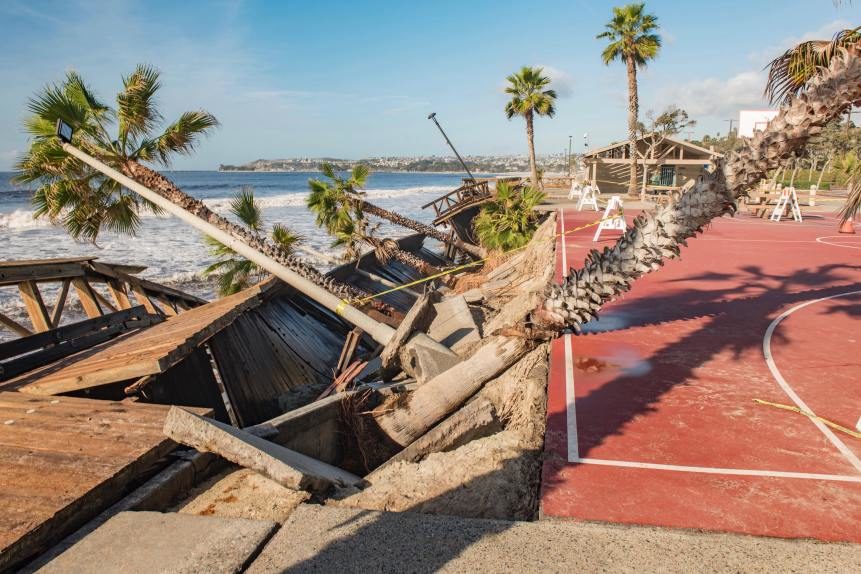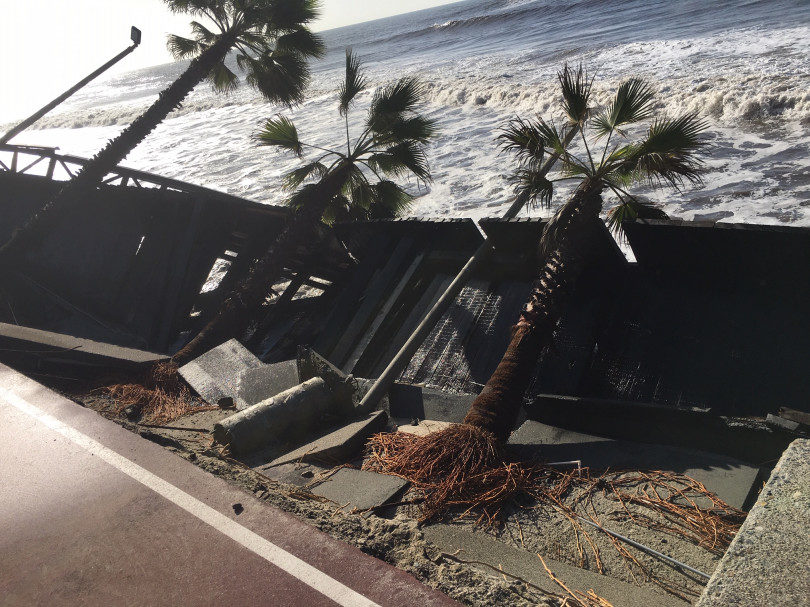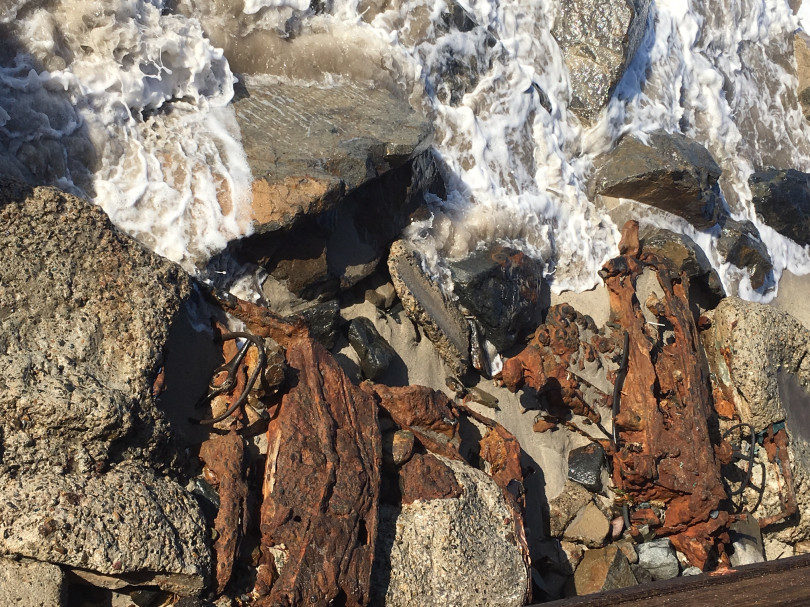
The popular basketball court was closed, the wooden walkway and seawall just south of where they stood crumbled, and decades-old palms were uprooted, pointing out to the ocean's horizon after this week's storms battered the area.
But the seaside scene of destruction isn't what caught the eye of the two Capo Beach residents out Saturday for an early morning walk.
"Look at all the cars, that's crazy, the steering wheels and tires," said Miller, pointing to the pieces of old cars embedded in boulders, now exposed.
Rain, big waves and high tides wreaked havoc on the small stretch of beach in Dana Point, an area that has already taken a beating in recent years from storm surges, and environmental watchers say, an example of rising sea levels.
Toni Nelson, a Capistrano Beach resident who has kept a close eye on the area's continued destruction, said she's been in touch with OC Parks and the city manager concerning the damage.
"We're in crisis mode now," said Nelson, who runs a Facebook page called Capo Cares. "Time to get things done."
No simple solution
The damage caused Friday, Nov. 30 was the worst yet in the area plagued by battering seas.
Earlier this summer, fire rings that have been used for sunset bonfire rituals for decades crumbled after being battered by storms.
The county removed two of the concrete circles permanently for safety reasons, while two others were relocated to a sandier stretch of beach.
For years, each time big surf slams the area, especially during extreme high tides, the beach is a mess, with rocks pushing up to the parking lot, concrete benches tossed around, and the parking lot closed as county workers with heavy equipment try to clean up the area.
The area's destruction has been a talking point for Rick Erkeneff, chairman of the South County Chapter of the Surfrider Foundation, who believes more has to be done about rising sea levels, the impacts along the coastline, and how communities will deal with the loss of one of their most precious resources - sand.
Communities usually have three possible ways of dealing with rising tides as they destroy a beach: do nothing and deal with maintenance costs after each event; put in heavy rocks and boulders that line the beach to try to block the sea; or consider long-term solutions such as moving paths and parking lots further back from the water, a response called "managed retreat."
"What's happening down there (at Capo Beach) is a symptom of what's to come for a lot of other beaches," Erkeneff said in a previous article about Capo Beach's erosion.
He said the rock solution, often called "rip rap" armor, can do more harm than good, blocking the natural flow of sand that would eventually come back to replenish a beach.
Areas such as Capo Beach and North Beach in San Clemente - lined by rocks where at high tides there's little or no sand - are examples of how the rocks can diminish a beach over time.
He believes urban development inland of Capistrano Beach and nearby San Clemente has "choked" out all of the sediment supply that would naturally bring down sand from creeks to the ocean.
Erkeneff said the city of Dana Point is doing a wave run-up study to figure out what zones are in danger of problems associated with rising sea levels.
Disappearing coast
In October, a concrete walkway at Beach Road buckled, cracked and crumbled after pounding waves destroyed the area.
The coastal erosion is so bad that the area's past is being exposed. When the concrete walkway a few months ago was destroyed, Nelson found pieces of light blue tile wedged between rocks, possibly evidence of an old beach club's pool, buried under the beachfront parking lot.
The odd scene south of that area that appeared with this week's storm damage - the pieces of cars exposed from decades ago - was a sight for history buffs.
"The story is, in the 60s or 50s, they crunched (the cars) up and put them there and put cement inside to keep the waves from beating everything up," Miller said.
"Evidently, it didn't work."
Capo resident Brian Brandt jogs the path every day and noticed Friday workers putting up caution tape near the courts.
"Hurry up down here before this is going to wash away," he wrote on social media, jokingly.
He went back a few hours later and the wooden walkway abutting the courts was "all the way in the ocean."
"It happened unbelievably quick," he said. "Nobody can believe it."
Nelson said the county and city have been responsive, but the latest damage - with a staircase gone and tall light fixtures also damaged - could urge state officials to speed up the process to safeguard the area.
"We have to get it moving and come up with an emergency solution," she said. "We have to do mitigation to protect what we have, the restrooms and basketball courts. That's a big investment for the county. There's no way we want to see this get lost."
She's especially sad about the continued loss of palm trees. To date, about 20 were uprooted from storms.
"We know, eventually this is gone .. we want to keep what we can," she said.
Longtime Capo resident Matt Larmand went down to shoot images of what's left at the beach where he was raised.
"It's sad to see all the beaches in the area disappearing so fast. I grew up playing basketball and hanging out down there and now it's all falling into the ocean," he said. "I wish something could be done to stop the coast from disappearing."
Laylan Connelly started as a journalist in 2002 after earning a degree in journalism from the University of Southern California. Through the years, she has covered several cities for The Orange County Register, starting as a beat reporter in Irvine before focusing on coastal cities such as Newport Beach, Dana Point and Laguna Beach. In 2007, she was selected for a prestigious Knight New Media fellowship focusing on digital media at UC Berkeley. Reach her at lconnelly@scng.com





Reader Comments
tell the waves to stop flappin'... it s OUR sand!!
throw more cars in there why dont ya....
MOVE????
oh brother!! Washey Rincey and Spiney REPEAT